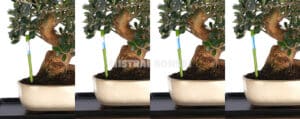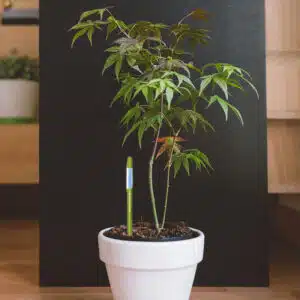Aqua meter: 20 FAQ for plant care

Did you know that 80% of plant wilting is due to watering problems? If you have trouble understanding your plant’s watering needs and you doubt when to water them, then the Aqua meter will become your best friend. Today we introduce the 20 most frequently asked questions about this watering indicator. It is very easy to install and just by looking at it you will know if your plant needs to be watered for getting a proper plant care.
1. What do the colours blue and white mean?
When the Aqua meter is blue, it means that the soil is properly hydrated and does not need to be watered. When it is white, it tells us that the soil is a bit dry and needs to be watered.
2. How does it work?
Aqua meter is designed to change colour around 2.0 pF, which marks the amount of water available in the substrate.
3. Where and how deep should it be inserted?
The indicator detects the humidity level around the roots, at the bottom of the pot. It should therefore be placed n
ear the trunk, depending on the size of your pot and the size of your Aqua meter. Insert the indicator between the marks ▼▲ (placeholders).
4. How do I know which is the best size for my plant?
Size S – 12 cm long
- Bonsai pots: approximately 20 cm wide or with bonsai up to 8 years old.
- Round pots: diameter between 6 and 9 cm. Pots that can be lifted with one hand.
Size M – 18 cm long
- Bonsai pots: approximately 30 cm wide or with bonsai up to 16 years old.
- Round pots: diameter between 10.5 and 18 cm. Pots that can be lifted with both hands.
5. When should I water?
When the indicator is completely white, it means it is not detecting root moisture, so the plant needs to be watered.
6. Is it recommended that the indicator always show blue?
We recommend watering only when the indicator is completely white, without showing the slightest shade of blue, because at that point the roots will be oxygenated and produce the necessary gas exchange.
7. How much water should I use to ensure a proper plant care?
There is no exact amount. You should water until the water runs out of the drainage holes in the pot, and once it has drained completely, you should remove any excess water left in the saucer.
8. How long does it take to change colour?
Depending on the amount of water you use and the retention level of the substrate, it will take between 3 and 25 minutes.
9. Does it expire?
You can use the Aqua meter between 6 and 9 months, since the reagent inside wears out with use. When it stops working, it will remain fixed in a single colour.
10. Does it need batteries?
It does not need batteries of any type.
11. How should I maintain the watering indicator?
After prolonged use, it is possible that the indicator may not react as it should. If this happens, soak the indicator in a solution of detergent and warm water for one hour, so that the particles adhered to the indicator can be loosened.
12. Can it be used with any type of plant?
You can use it with almost all plants that grow in soils with a certain level of humidity retention: gardening soil, Akadama, black soil, bark, coco fibre, moss, vermiculite…
It can also be used in hydroponic or bottom watering crops, among others.
13. Does it work with different types of plants?
Yes, it can be used with orchids, succulents, houseplants, bonsai, flowering plants, etc. All plants share a beneficial soil moisture range called “available water capacity”, which refers to the moisture management of all plants, preventing them from drying out or rotting their roots. The Aqua meter helps us to maintain this adequate moisture range, ensuring a good plant care.
14. What should I do if I do not see any colour change in the indicator after watering?
To know what to do, the first thing we need to do is to find out what could be the cause:
- If it is the first time you use it, you need to water abundantly.
- If the indicator is clogged, you should clean it as explained in question 11.
- If the soil drains too quickly, the indicator does not have time to absorb the moisture properly in order to activate.
- If none of the above solves the problem, it is possible that the indicator has expired and needs to be replaced.
15. Is it affected by water from spraying or rain?
No, the Aqua meter only indicates the amount of moisture in the centre of the substrate.
16. Why does the colour change vary at different rates?
It is due to environmental conditions and where it is placed.
17. Is the colour change altered by the change of seasons?
Yes. Depending on the ambient temperature, the water in the substrate evaporates more or less quickly. Therefore, in summer and spring it will turn white faster than in autumn or winter.
18. Do fertilizers and pesticides affect it?
No, as long as they have a low level of oil and are not used in excess.
19. Can I delay watering?
The value visible in the indicator is a guide, so it is possible to delay watering your plant if you think it does not need it yet.
20. How do I know if the Aqua meter is working properly for my plant care?
To check that the Aqua meter is working properly, dip it in a container of water. It should change colour as the reagent gets wet. If there is no colour change after a few minutes, the indicator may be clogged or expired and need to be replaced.
In short, the Aqua meter is a very useful device for the caring of your plants, especially if you have bonsai trees. With this FAQ guide, you will be able to understand how it works and how to use it correctly to ensure your plants are always well hydrated and healthy for getting a proper plant care.
*Plant photos source: Unsplash
Find out more about watering in this Ficus retusa care blog:
About the Author
Mistral Bonsai
In Mistral Bonsai we are a communication team, technicians and masters committed from the first day to disseminating the wonderful art of bonsai. A world that offers many things to share. We believe that a bonsai is a tree with a soul, unique and unrepeatable. Another of our most essential pillars is, how could it be otherwise, our close commitment to the preservation of the environment and nature.
Categories
Bonsai cultivation and care (60)
Bonsai gift (2)
Bonsai pests and diseases (7)
Bonsai repotting (3)
Bonsai species (1)
bonsai substrates (2)
Bonsai summer (1)
bonsai tools (1)
Bonsai work (13)
Ceramic pots (3)
Chinese culture (1)
Chinese culture (2)
Coniferous bonsai (2)
Conifers (1)







